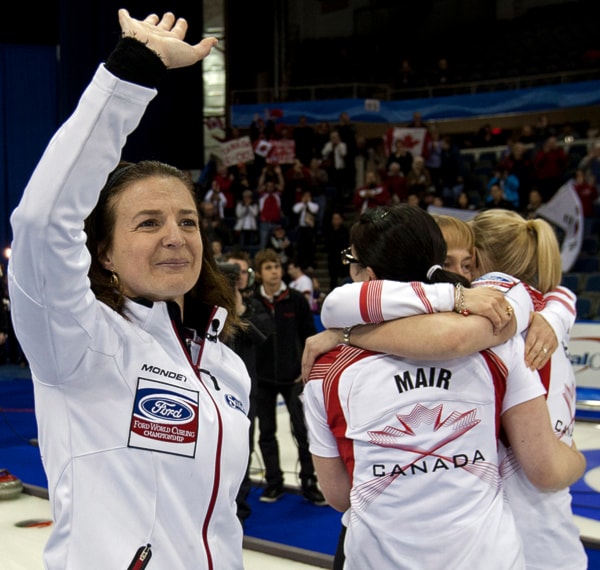LETHBRIDGE — Heather Nedohin’s team passed a test of mental toughness by earning a hard-fought bronze medal for Canada at the women’s world curling championship.
But with the next Winter Olympics less than two years away, are Canada’s top female curlers equipped to win amid challenges by countries which take an increasingly professional approach to the sport?
Canadian women have won world championship gold three times in the last decade. At the Olympics, it’s been two bronze and a silver since Sandra Schmirler’s gold in 1998 when curling made its Olympic debut. Canadian men have stood higher on the international podium more often with six world titles and two Olympic gold in the last 10 years.
Men’s elite teams in Canada outnumber women’s, making the process of natural selection effective in producing a men’s team that can beat the rest of the world.
The South Korean team that Canada defeated 9-6 for bronze Sunday, but also lost 4-3 to in a playoff game Saturday, is a professional outfit.
Curling will be the full-time jobs of Ji-Sun Kim and her teammates for the next six years until South Korea hosts the 2018 Winter Olympics in Pyeongchang.
China and Russia have also taken five or six female curlers and poured time and resources into them to produce a competitive team. That approach has yet to bear fruit for Russia, host of the 2014 Winter Games in Sochi. Their women are still looking for their first world championship medal.
The results have been mixed for China as Bingyu Wang won a world title in 2009 and an Olympic bronze the following year.
But Wang wasn’t on the radar at this world championship with a 3-8 record.
Switzerland’s Mirjam Ott edged Sweden’s Margaretha Sigfriddson 7-6 for gold Sunday. Sweden and Switzerland have curling systems more like Canada as they have enough depth to make for tough domestic competition.
Sigfriddson, for example, had to beat two-time Olympic and three-time world champion Anette Norberg to get to Lethbridge.
It also bears pointing out countries like, China, South Korea and Russia put their best women’s team in Canada for weeks during the winter to train and face Canadian competition on the World Curling Tour.
Canada is still seen as a curling hot-house where other countries can fast-track the development of their teams.
Canada’s female curlers aren’t full-time athletes, nor will they be in the foreseeable future.
National champions receive funding from Own The Podium and Sport Canada for a two-year period, but many juggle the sport with childbirth, child-rearing and full-time jobs.
“When you hear about specialized teams or teams in foreign countries and it’s the core six and they’re practising four or five hours a day, how can you not get better?” Nedohin said as youngest daughter Alyssa hugged her mom’s knees.
“Myself, I’m at the rink maybe two hours, three hours? Honestly, two hours. If I could get an extra couple more hours in a day, I think I would be that much better.”
While Nedohin isn’t employed outside the home, her three teammates are. The skip points out they make more money at their jobs than they would as a full-time athlete.
Canada’s high performance curling system isn’t a free-for-all either. The top six women’s teams have access to Canadian Curling Association resources, coaching and sport science research.
“As soon as they hit the radar screen within their province or the national-team program, then they come into a very sophisticated training system, which I think is better than what they’re doing internationally,” Canadian women’s team coach Elaine Dagg-Jackson said.
“Is there a benefit of taking five people and practising five hours a day every day for four years. Of course, there’s a benefit, but does that outweigh the benefit of Heather Nedohin’s 20 years of skipping experience? No, I don’t think so. Our sport is much bigger than a few people. That allows the best to rise up.”
Dagg-Jackson says she is heavily scouting the 24 female curlers in the national-team pool.
“We are looking for very specific things to get two, three or four per cent increase in performance,” the coach explained.
“This season, with our national teams, we’re going to go look at every single player individually and look for what are the very specific things they need to do. It might be sweeping and communication for one team. It might be weight control with another team.”
Canada has finished out of the medals just five times in the 34-year history of the women’s world championship. Nedohin’s team battled fatigue and the disappointment of not playing for gold to keep Canada among the world’s elite.
“It extremely important,” Nedohin said. “For us, it’s all about winning your last game and for us, we went out and played solid right until the end.
“A medal at this level is a very proud moment.”
The men’s world curling championship opens Saturday in Basel, Switzerland. Glenn Howard, Wayne Middaugh, Brent Laing and Craig Savill out of the Coldwater Curling Club in Ontario will represent Canada.
The 2013 women’s world championship will be in Riga, Latvia.
